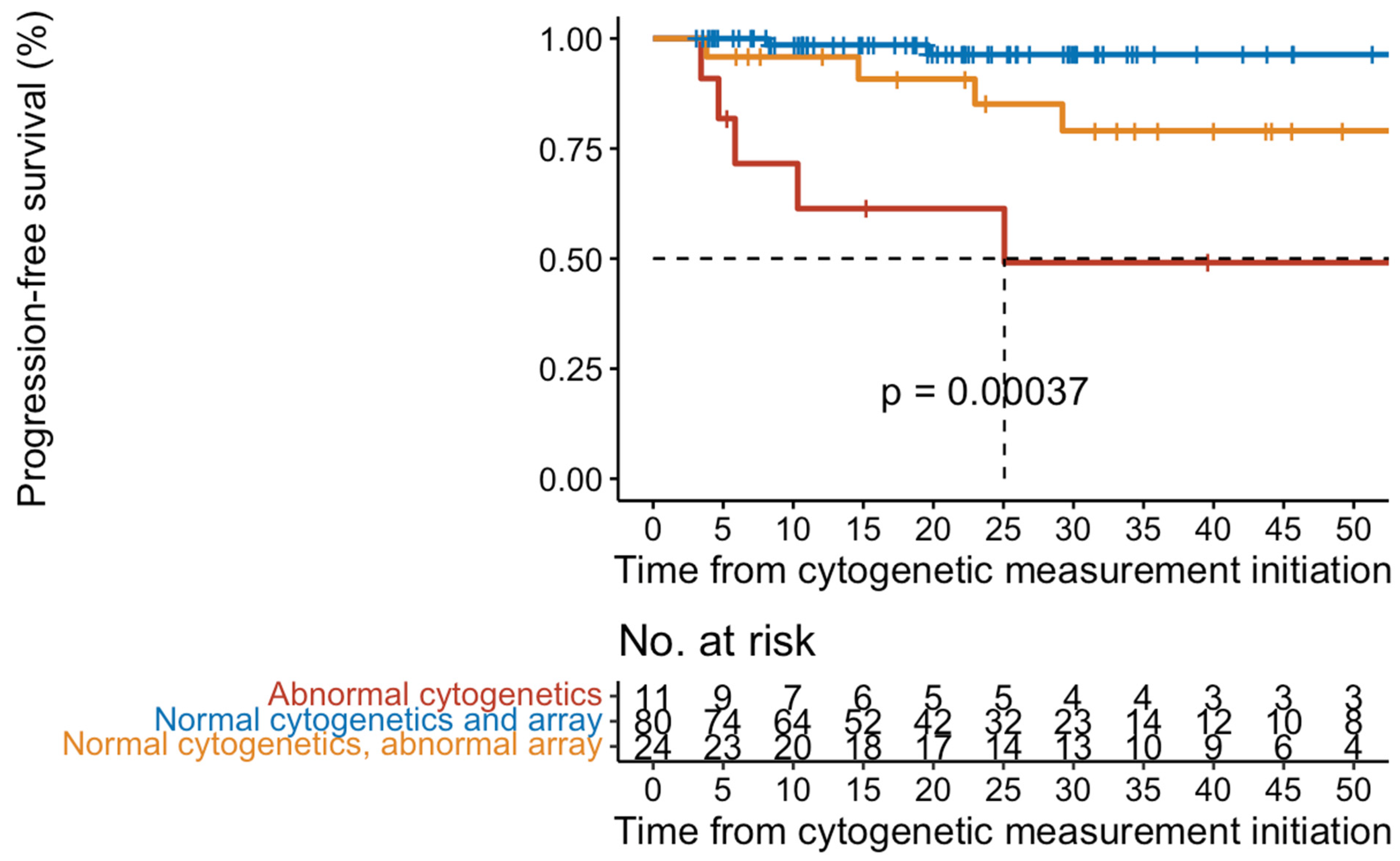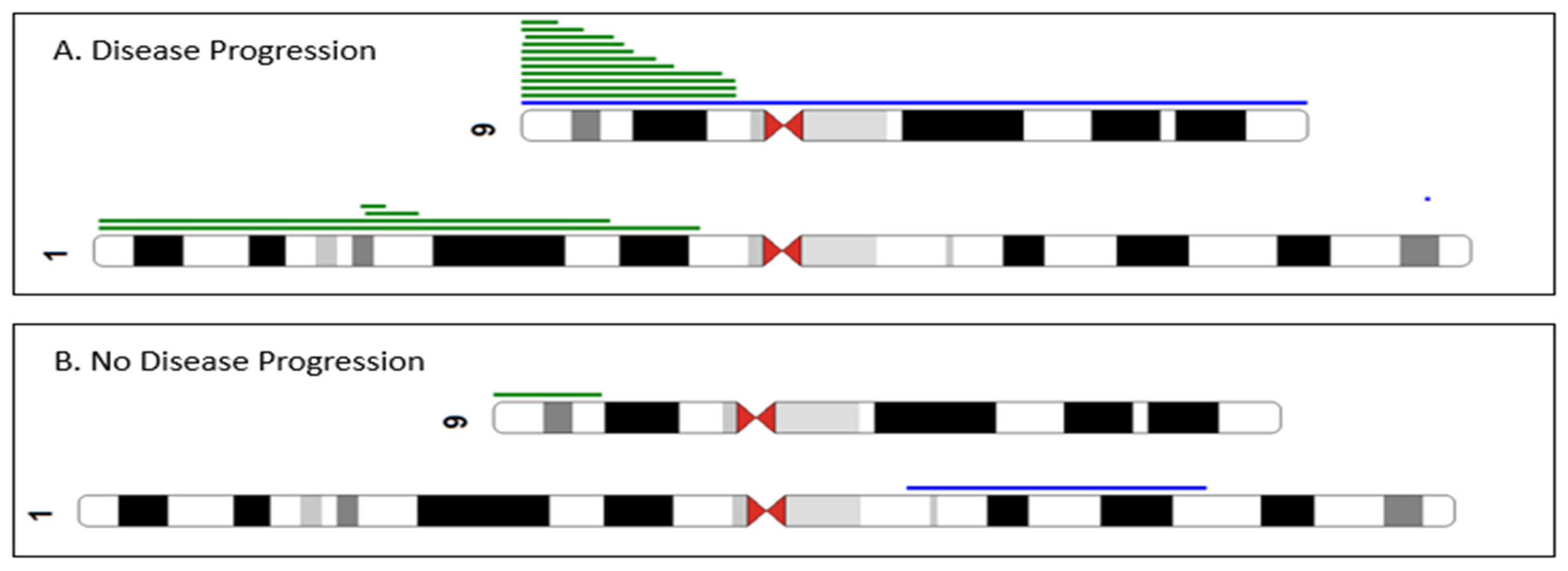Conventional Cytogenetic Analysis and Array CGH + SNP Identify Essential Thrombocythemia and Prefibrotic Primary Myelofibrosis Patients Who Are at Risk for Disease Progression
Abstract
1. Introduction
2. Results
2.1. Baseline Characteristics
2.2. Disease Progression
2.3. Conventional Cytogenetic Results
2.4. Array-CGH + SNP Results
3. Discussion
4. Materials and Methods
4.1. Patients
4.2. Conventional Cytogenetics/Chromosomal Microarray
4.3. Next Generation Sequencing
4.4. Statistics
Author Contributions
Funding
Institutional Review Board Statement
Informed Consent Statement
Data Availability Statement
Conflicts of Interest
References
- Khoury, J.D.; Solary, E.; Abla, O.; Akkari, Y.; Alaggio, R.; Apperley, J.F.; Bejar, R.; Berti, E.; Busque, L.; Chan, J.K.C.; et al. The 5th Edition of the World Health Organization Classification of Haematolymphoid Tumours: Myeloid and Histiocytic/Dendritic Neoplasms. Leukemia 2022, 36, 1703–1719. [Google Scholar] [CrossRef] [PubMed]
- Gangat, N.; Jadoon, Y.; Szuber, N.; Hanson, C.A.; Wolanskyj-Spinner, A.P.; Ketterling, R.P.; Pardanani, A.; Tefferi, A. Cytogenetic Abnormalities in Essential Thrombocythemia: Clinical and Molecular Correlates and Prognostic Relevance in 809 Informative Cases. Blood Cancer J. 2022, 12, 44. [Google Scholar] [CrossRef] [PubMed]
- Kim, T.-Y.; Kwag, D.; Lee, J.-H.; Lee, J.; Min, G.-J.; Park, S.-S.; Park, S.; Jeon, Y.-W.; Yoon, J.-H.; Shin, S.-H.; et al. Clinical Features, Gene Alterations, and Outcomes in Prefibrotic and Overt Primary and Secondary Myelofibrotic Patients. Cancers 2022, 14, 4485. [Google Scholar] [CrossRef] [PubMed]
- Tefferi, A.; Guglielmelli, P.; Larson, D.R.; Finke, C.; Wassie, E.A.; Pieri, L.; Gangat, N.; Fjerza, R.; Belachew, A.A.; Lasho, T.L.; et al. Long-Term Survival and Blast Transformation in Molecularly Annotated Essential Thrombocythemia, Polycythemia Vera, and Myelofibrosis. Blood 2014, 124, 2507–2513. [Google Scholar] [CrossRef] [PubMed]
- Yogarajah, M.; Tefferi, A. Leukemic Transformation in Myeloproliferative Neoplasms A Literature Review on Risk, Characteristics, and Outcome. Mayo Clin. Proc. 2017, 92, 1118–1128. [Google Scholar] [CrossRef] [PubMed]
- Gangat, N.; Wolanskyj, A.P.; McClure, R.F.; Li, C.-Y.; Schwager, S.; Wu, W.; Tefferi, A. Risk Stratification for Survival and Leukemic Transformation in Essential Thrombocythemia: A Single Institutional Study of 605 Patients. Leukemia 2007, 21, 270–276. [Google Scholar] [CrossRef] [PubMed]
- Finazzi, G.; Caruso, V.; Marchioli, R.; Capnist, G.; Chisesi, T.; Finelli, C.; Gugliotta, L.; Landolfi, R.; Kutti, J.; Gisslinger, H.; et al. Acute Leukemia in Polycythemia Vera: An Analysis of 1638 Patients Enrolled in a Prospective Observational Study. Blood 2005, 105, 2664–2670. [Google Scholar] [CrossRef] [PubMed]
- Marcellino, B.K.; Verstovsek, S.; Mascarenhas, J. The Myelodepletive Phenotype in Myelofibrosis: Clinical Relevance and Therapeutic Implication. Clin. Lymphoma Myeloma Leuk. 2020, 20, 415–421. [Google Scholar] [CrossRef] [PubMed]
- Grinfeld, J.; Nangalia, J.; Baxter, J.E.; Wedge, D.C.; Angelopoulos, N.; Cantrill, R.; Godfrey, A.L.; Papaemmanuil, E.; Gundem, G.; MacLean, C.; et al. Classification and Personalized Prognosis in Myeloproliferative Neoplasms. N. Engl. J. Med. 2018, 379, 1416–1430. [Google Scholar] [CrossRef] [PubMed]
- Masarova, L.; Verstovsek, S. The Evolving Understanding of Prognosis in Post-Essential Thrombocythemia Myelofibrosis and Post-Polycythemia Vera Myelofibrosis vs Primary Myelofibrosis. Clin. Adv. Hematol. Oncol. 2019, 17, 299–307. [Google Scholar]
- López, J.E.H.; Carballo-Zarate, A.; Verstovsek, S.; Wang, S.A.; Hu, S.; Li, S.; Xu, J.; Zuo, W.; Tang, Z.; Yin, C.C.; et al. Bone Marrow Findings in Blast Phase of Polycythemia Vera. Ann. Hematol. 2018, 97, 425–434. [Google Scholar] [CrossRef] [PubMed]
- Tefferi, A. Primary Myelofibrosis: 2023 Update on Diagnosis, Risk-stratification, and Management. Am. J. Hematol. 2023, 98, 801–821. [Google Scholar] [CrossRef] [PubMed]
- Gangat, N.; Tefferi, A.; Thanarajasingam, G.; Patnaik, M.; Schwager, S.; Ketterling, R.; Wolanskyj, A.P. Cytogenetic Abnormalities in Essential Thrombocythemia: Prevalence and Prognostic Significance. Eur. J. Haematol. 2009, 83, 17–21. [Google Scholar] [CrossRef] [PubMed]
- Wang, L.; Wheeler, D.A.; Prchal, J.T. Acquired Uniparental Disomy of Chromosome 9p in Hematologic Malignancies. Exp. Hematol. 2016, 44, 644–652. [Google Scholar] [CrossRef] [PubMed]
- Rumi, E.; Harutyunyan, A.; Elena, C.; Pietra, D.; Klampfl, T.; Bagienski, K.; Berg, T.; Casetti, I.; Pascutto, C.; Passamonti, F.; et al. Identification of Genomic Aberrations Associated with Disease Transformation by Means of High-resolution SNP Array Analysis in Patients with Myeloproliferative Neoplasm. Am. J. Hematol. 2011, 86, 974–979. [Google Scholar] [CrossRef] [PubMed]
- Guglielmelli, P.; Szuber, N.; Gangat, N.; Capecchi, G.; Maccari, C.; Harnois, M.; Karrar, O.; Abdelmagid, M.; Balliu, M.; Nacca, E.; et al. CALR Mutation Burden in Essential Thrombocythemia and Disease Outcome. Blood 2024, 143, 1310–1314. [Google Scholar] [CrossRef] [PubMed]
- Ayres-Silva, J.P.; Bonamino, M.H.; Gouveia, M.E.; Monte-Mor, B.C.; Coutinho, D.F.; Daumas, A.H.; Solza, C.; Braggio, E.; Zalcberg, I. Genetic Alterations in Essential Thrombocythemia Progression to Acute Myeloid Leukemia: A Case Series and Review of the Literature. Front. Oncol. 2018, 8, 32. [Google Scholar] [CrossRef] [PubMed]
- Hahm, C.; Huh, H.; Mun, Y.; Seong, C.; Chung, W.; Huh, J. Genomic Aberrations of Myeloproliferative and Myelodysplastic/Myeloproliferative Neoplasms in Chronic Phase and during Disease Progression. Int. J. Lab. Hematol. 2015, 37, 181–189. [Google Scholar] [CrossRef] [PubMed]
- Zimran, E.; Tripodi, J.; Rampal, R.; Rapaport, F.; Zirkiev, S.; Hoffman, R.; Najfeld, V. Genomic Characterization of Spleens in Patients with Myelofibrosis. Haematologica 2018, 103, e446–e449. [Google Scholar] [CrossRef] [PubMed]


| Variables | All Patients (n = 169) | No Progression (n = 119) | Progression (n = 50) |
|---|---|---|---|
| Age in years, median (range) | 62 (13–92) | 56 (13–92) | 67 (31–89) |
| Gender (female), n (%) | 96 (57) | 70 (59) | 26 (52) |
| Cytogenomic Results | |||
| Normal, n (%) | 108 (64) | 92 (77) | 16 (9) |
| Abnormal, n (%) | 61 (36) | 27 (23) | 34 (68) |
| Driver Mutations | |||
| N, evaluable | n = 166 | n = 116 | n = 50 |
| JAK2, n (%) | 99 (60) | 68 (59) | 31 (62) |
| MPL, n (%) | 13 (8) | 9 (8) | 4 (8) |
| CALR, n (%) | 35 (21) | 23 (20) | 12 (24) |
| JAK2/CALR, n (%) | 2 (1) | 2 (2) | 0 (0) |
| Triple Negative, n (%) | 17 (10) | 14 (12) | 3 (6) |
| Next Generation Sequencing | |||
| Adverse Molecular Risk (MIPSS-ET) | |||
| N, evaluable | n = 165 | n = 115 | n = 50 |
| 1 gene, n (%) | 13 (8) | 3 (3) | 10 (20) |
| ≥2 gene, n (%) | 1 (<1) | 0 (0) | 1 (2) |
| ID# | Age | Diagnosis | Gender | Tissue | Cytogenetics Karyotype | Array | Mutations | Progression to: |
|---|---|---|---|---|---|---|---|---|
| 1 | 75 | ET | M | BM | 45,XY,add(4)(p14),der(5;17)(p10;q10),der(8)add(8)(p11.2)add(8)(q13),add(13)(p11.2),der(15)t(15;16)(p11.2;q11.2),-16,-18,add(19)(q13.3),del(21)(q21q22),+2mar[cp19]/ 46,XY[1].ish der(4)del(4)(p14p16)ins(4;8)(p14;q24.3q23)(MYC+),der(5;17)(p10;q10)(D17Z1+),der(8)(?::8p11.2->8q12::8q24.1->8q22::8q23->8q22::8q23->8q24.1::?)(D8Z2+,MYC++),der(13)(8qter::8q22->8q24.3::13p11.2->13qter)(MYC+) | ND | JAK2 | AP/BP |
| 2 | 55 | ET | M | BM | 47,XY,+Y,t(11;19)(q23;p13.1)[16]/ 46,XY[4] | ND | Triple Negative | AP/BP |
| 3 | 74 | ET | M | BM | 42~43,X,-Y,add(5)(q11.2),add(7)(p13),?t(9;17)(q21;p13),-15,-16,der(19)t(15;19)(q11.2;p13.3),-21[cp3]/46,XY[17] | ND | JAK2 | AP/BP |
| 4 | 73 | ET | F | PB | 46,XX,del(12)(p12p13)[14]/47,idem,+8[2]/46,XX,t(1;9)(p13;q32),del(12)(p12p13)[cp2]/46,XX[3] ADDENDUM on 8/21/2019: 46,XX,del(12)(p12p13).ish t(7;12)(q36;p13)(5′ETV6+;3′ETV6+) | 4q24(106036993_106456054)x1, 9p24.3p13.1(0_38694064)x2 hmz | JAK2 | AP/BP |
| 5 | 65 | ET | F | BM | 46,XX,der(5;19)(p10;q10),+19[5]/45,XX,der(5)t(5;9)(q13;p22),der(7)add(7)(p12)add(7)(q22),add(9)(p22),t(12;19)(p13;q13.1),-13,-15,add(17)(q21.3),+mar[4]/44,sl,-9,der(14)t(9;14)(q22;p24),der(16)t(9;16)(p22;p13.1)[2]/46,XX[18]/47,XX,i(9)(p10),+mar[1] | ND | JAK2 | AP/BP |
| 6 | 67 | ET | F | BM | 48,XX,+8,+8[20] | 8p23.3q24.3(0_146293435)x4, 9p24.3p21.3(0_24234310)x2 hmz | JAK2, IDH1, SRSF2 | AP/BP |
| 7 | 51 | ET | M | BM | 46,XY,del(15)(q15q23),t(17;18)(p12;q11.2) [7]/46,XY[13] | ND | CALR, TET2 | MF |
| 8 | 45 | ET | F | PB | 46,XX,del(13)(q12q14)[4]/ 46,XX,del(13)(q12q32)[4]/ 46,XX,dup(1)(q21q42)[3]/ 48,XX,+der(1)t(1;19)(p12;p12),+8[2]/ 46,XX[7] | ND | Triple Negative, SH2B3 | MF |
| 9 | 39 | ET | F | PB | 46,XX,del(13)(q12q14)[8]/ 46,XX[7] | ND | Triple Negative | MF |
| 10 | 80 | ET | M | BM | 45,X,-Y[16]/46,idem,+8[3]/ 45,XY,-3[1] | ND | JAK2, SRSF2 | No Progression |
| 11 | 74 | ET | F | BM | 46,XX,del(20)(q11.2q13.3)[11]/ 46,XX[9] | ND | JAK2, TET2 | MF |
| 12 | 54 | ET | M | PB | 47,XY,+Y[20] | Yp11.32q12(0_59373566)x3 | JAK2 | No Progression |
| 13 | 81 | ET | M | #N/A | 45,X,-Y[18]/ 46,XY[2] | Yp11.32q12(0_59373566)x0 | JAK2 | No Progression |
| 14 | 73 | ET | M | BM | 45,X,-Y[7]/ 46,XY[22]/ 46,XY,?del(8)(q22)[1] | ND | Not Performed | No Progression |
| 15 | 38 | ET | M | PB | 46,XY,+9,-14[1]/ 46,XY[6] | 9p24.3q34.3(0_141213431)x3 | JAK2 | MF |
| 16 | 70 | ET | M | BM | 46,XY,der(6)t(3;6)(q25;p22)[20] | Xq26.2q26.3(133506194_134184567)x0, 1p36.13p22.1(1089699_93720070)x2 hmz, 3q25.32q29(157780129_197861598)x3, 6p25.3p22.1(204009_27534514)x1 | MPL, TET2 | MF |
| 17 | 83 | ET | F | BM | 46,XX,del(13)(q12q14)[3]/ 46,XX[17] | ND | JAK2 | No Progression |
| 18 | 72 | ET | F | BM | 46,XX,del(20)(q11.2q13.3)[1]/ 46,XX[19] | 9p24.3p13.1(0_38694064)x2 hmz | JAK2, DNMT3A | MF |
| 19 | 89 | ET | M | BM | 46,XY,del(13)(q12q14)[5]/ 46,XY,del(13)(q12q22)[3]/ 46,XY[12] | ND | MPL | MF |
| 20 | 67 | ET | F | PB | 46,XX,der(6)t(1;6)(q21;p25),t(9;11)(p24;q21),del(13)(q12q22)[1]/ 46,idem,del(11)(q14q23)[8]/ 46,idem,del(12)(p13p11.2)[7]/ 46,XX,t(11;17)(p15;q11.2)[4] | ND | JAK2, DNMT3A, EZH2 | AP/BP |
| 21 | 81 | ET | M | BM | 46,XY,t(9;22)(q34;q11.2)[20] | ND | JAK2 | CML |
| 22 | 52 | ET | M | BM | 46,XY,del(13)(q12q22)[9]/ 46,XY[11] | ND | JAK2, GATA1 | MF |
| 90 | 65 | prePMF | F | BM | 45,XX,del(12)(p11.2p13),-18[1]/ 46,XX[17] | ND | JAK2, RUNX1, SF3B1*, STAG2 | MDS |
| 156 | 64 | ET | M | BM | 47,XY,+9[4]/ 46,XY[15]/ 47,XY,+18[1] | ND | JAK2 | PV |
| 163 | 77 | ET | F | BM | 46,XX,dup(1)(q21q32)[8]/ 46,XX[12] | 1q21.2q32.1(150189472_204513328)x3, 5q21.3q23.1(107501113_115990907)x1 | CALR | No Progression |
| 167 | 80 | ET | M | BM | 46,XX,del(20)(q11.2q13.1)[4]/ 46,XX[16] | 9p24.3p22.1(0_19585456)x2 hmz, 17p11.2(17803134_19293234)x1~2, 20q11.23q13.2(34975018_50468054)x1 | JAK2 | No Progression |
| 169 | 77 | ET | M | BM | 46,XY,del(20)(q11.2q13.3)[14]/ 46,XY[6] | 9p24.3p24.1(0_6651634)x2 hmz, 20q11.21q13.32(32060886_58171738)x1, Yp11.32q12(0_59373566)x0 | JAK2 | MF |
Disclaimer/Publisher’s Note: The statements, opinions and data contained in all publications are solely those of the individual author(s) and contributor(s) and not of MDPI and/or the editor(s). MDPI and/or the editor(s) disclaim responsibility for any injury to people or property resulting from any ideas, methods, instructions or products referred to in the content. |
© 2024 by the authors. Licensee MDPI, Basel, Switzerland. This article is an open access article distributed under the terms and conditions of the Creative Commons Attribution (CC BY) license (https://creativecommons.org/licenses/by/4.0/).
Share and Cite
Tripodi, J.; Hoffman, R.; Tremblay, D.; Ahire, D.; Mascarenhas, J.; Kremyanskaya, M.; Najfeld, V. Conventional Cytogenetic Analysis and Array CGH + SNP Identify Essential Thrombocythemia and Prefibrotic Primary Myelofibrosis Patients Who Are at Risk for Disease Progression. Int. J. Mol. Sci. 2024, 25, 4061. https://doi.org/10.3390/ijms25074061
Tripodi J, Hoffman R, Tremblay D, Ahire D, Mascarenhas J, Kremyanskaya M, Najfeld V. Conventional Cytogenetic Analysis and Array CGH + SNP Identify Essential Thrombocythemia and Prefibrotic Primary Myelofibrosis Patients Who Are at Risk for Disease Progression. International Journal of Molecular Sciences. 2024; 25(7):4061. https://doi.org/10.3390/ijms25074061
Chicago/Turabian StyleTripodi, Joseph, Ronald Hoffman, Douglas Tremblay, Daiva Ahire, John Mascarenhas, Marina Kremyanskaya, and Vesna Najfeld. 2024. "Conventional Cytogenetic Analysis and Array CGH + SNP Identify Essential Thrombocythemia and Prefibrotic Primary Myelofibrosis Patients Who Are at Risk for Disease Progression" International Journal of Molecular Sciences 25, no. 7: 4061. https://doi.org/10.3390/ijms25074061
APA StyleTripodi, J., Hoffman, R., Tremblay, D., Ahire, D., Mascarenhas, J., Kremyanskaya, M., & Najfeld, V. (2024). Conventional Cytogenetic Analysis and Array CGH + SNP Identify Essential Thrombocythemia and Prefibrotic Primary Myelofibrosis Patients Who Are at Risk for Disease Progression. International Journal of Molecular Sciences, 25(7), 4061. https://doi.org/10.3390/ijms25074061






